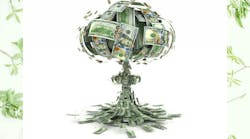Filling the income gap of traditional retirement planning
Without a clear destination, you may remain stuck in practice for years longer than necessary, preferring the perceived safety of the status quo (trading time for dollars) over the uncertainties of market volatility, inflation, and an unclear future.
The question that stands between you and a clear path to retirement is... how much is enough?
The 401(k) model: Avoiding taxes is costing your future
I regularly speak to doctors who have worked hard for decades and accumulated enough net worth in their 40s or early 50s to begin buying back their time after running on the hamster wheel of their practice. Unfortunately, those who have invested heavily into 401(k)s are unable to access the wealth they've accumulated without incurring a significant penalty. Despite having enough to retire, they are forced to keep working unnecessarily because they cannot access their own money. It's frustrating to feel stuck behind the chair despite having diligently built a significant nest egg.
401(k)s are marketed as a tax reduction strategy, but they actually defer taxes rather than mitigate them. It's important to be wary of trading your future freedom for current tax savings.
Taxes are nettlesome, but keeping your capital outside of retirement accounts offers the flexibility to buy back time on your own terms - -not wait until a distant retirement "someday." After all, what use is freedom if you're too old to enjoy it?
The turning of a 40 year cycle
In 1964, Bob Dylan released "The Times They Are a-Changin'" as a response to the tumult of that era. He said:
"Come gather 'round people, wherever you roam.
And admit that the waters around you have grown.
And accept it that soon you'll be drenched to the bone.
If your time to you is worth saving.
Then you better start swimmin' or you'll sink like a stone.
For the times, they are a-ichangin'.1
In January 1984, a young Steve Jobs recited the second verse of that song during the opening of the Apple shareholders meeting where he famously unveiled the Macintosh computer.
Today, Dylan's song could've been about the economy. We are currently experiencing a major turning point in a 40-year macro cycle with significant ramifications for investors.
For nearly half a century, we enjoyed declining interest rates and significant growth, often driven by artificial manipulation. Recently, however, inflation has spiked, and interest rates are rising.
This is not a "transitory" speed bump; we've entered a new phase of the economic cycle. If you owned or invested in any kind of tangible asset or financial product in the last decade, your asset or product value went up. Since this was a growth period, it was relatively easy to profit during this part of the cycle.
The issue lies in thinking that this increase in value is the way it always works. Be wary of recency bias ─ the fallacy of thinking that patterns will continue indefinitely. You cannot look back on the past with any predictive certainty of what it may look like in the future. Things will always change, so beware of any investment philosophies that assume that the next decade will follow the same trend as the last.
The uncertainty of "how much is enough" in an evolving world
Retirees may outlive their retirement savings and have no "safe place" to hold their capital. In 2022, the 60/40 traditional mix of stocks/bonds portfolio had its worst performance since the Great Depression, falling over 22%.
Because of this, you cannot and should not rely on the past performance of any model. Failing to advocate for your financial future may lead to an unexpected outcome you didn't prepare for.
The freedom number and replacement income
Determining your postcareer lifestyle numbers is the first step in determining how much you'll need and when you'll need it. You must reverse engineer the numbers. As an example, let's say you need $150,000 annual income before tax. How much capital you need to retire depends on your rate of return:
-
At a 1% return, you need $15.0M capital investment (to achieve $150,000/year annual income).
-
At 2% return… $7.50M capital investment required.
-
4% return… $3.75M capital investment required.
-
8% return… $1.875M capital investment required.
-
10% return… $1.5M capital investment required.
Your ability to safely earn a higher rate of return on investment is essential. $1.5M in capital investment assets is not a tremendous amount of capital to acquire; with the right strategies employed, it can be gained in just a few years.
Ask yourself the following question: Is it worth learning about real wealth building to reduce your capital needs? That reduction could save you years of labor… all because you took the time and made the effort to understand where the real opportunities lie.
Personally, I like to build capital assets from real estate. Many people don't know how to properly invest and dismiss the venture entirely, but if you know what you're doing, you can forge a network to provide you with a constant pipeline of deal flow.
How much really is enough?
For me, the answer came from pivoting to alternative investments and focusing on growing cash flow. Doing this ultimately replaced my need for continuing to trade time for dollars behind the dental chair. I knew I had enough when my investments covered my lifestyle needs regardless of whether I spent another hour in my practice.
For those willing to lean away from traditional models and invest in replacement income, the relief and confidence that grows in a few short years is life changing. They may discover a newfound passion for their work. Everything changes when you have the agency and ability to make decisions without financial constraints.
Picture yourself turning the "old model" of financial independence on its ear and following a new path that creates wealth. See yourself translating the years of success you have experienced in practice into income streams that are no longer dependent on the work of your hands. Imagine the confidence that you can make as much money while working less, so you have more freedom to enjoy the things you've worked so hard for, with the people you love most!
It's possible. It all starts with doing the hard work of creating clarity about how much is enough and the courage to pursue the path less traveled.
Resources
1. Dylan B. The Times They Are a-Changin'. Song from 1964 album of the same name. https://en.wikipedia.org/wiki/The_Times_They_Are_a-Changin'_(song)








